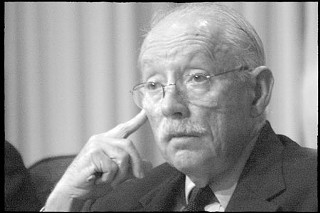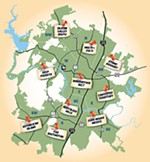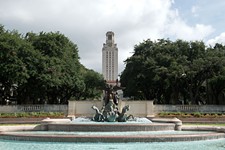Single-Member District Dilemmas
Process of drafting single-member-district proposal for Austin off to slow start
By Kimberly Reeves, Fri., Sept. 7, 2007
The time may have come for single-member districts in Austin – the city is now majority minority, like most larger cities in the nation – but it was hard to tell at a recent meeting of the city's Charter Revision Committee, which has begun exploring the issue.
Even former Mayor Gus Garcia, who chairs the committee, admitted after the Aug. 22 meeting that the process of drafting a proposal for single-member districts is off to a slow start. While a series of earnest speakers assured the committee it's time to move from an at-large system to single-member districts, attendance at the meeting was anemic, and it's obvious the committee will have to put something bold on the table to drum up interest.
DeWayne Lofton, who ran an unsuccessful race against Sheryl Cole in the last city election, was in the audience. He said he supports single-member districts. They provide more diverse representation and force candidates to focus on issues at the grassroots level, he said, as well as making campaigns a whole lot cheaper.
But Lofton's not convinced the committee is headed in the right direction – capable of building one vision within the next six months, in other words. And, without wholesale change, he suspects this effort will go down at the polls (just like the six attempts before it) for two reasons: "First, because it's designed to fail. We've drawn the maps in such a way that people tend to vote against the map instead of for the map," Lofton said. "Second, there has never been any coordinated campaign to get people out to vote for the map. That means it fell back on a small core of Central Austin voters to try to get this thing passed."
At the Aug. 22 meeting, city demographer Ryan Robinson presented an overview of Austin's changing demographics. One fact that stood out: The traditional bloc of African-American residents in East Austin has scattered to the north and south. Robinson said the best district he could draw was one with a population that was 35% African-American, and, even then, those African-Americans would be trumped by 44% Latinos. It's not likely that would sit well with the Department of Justice. The best the city could do for Asians would be to draw an opportunity district – one with a majority of Hispanics, African-Americans, and Asians – in the north end of the city.
Robinson has drawn these maps before – based on the sheer number of minorities in each voting precinct – so he understands the challenges. But the gaps continue to grow wider. For instance, the international immigrant population in Austin in 2000 was 8% of the city's overall growth. Five years later, it was 23% of overall growth.
Throw on top of that the income gradient from east to west – with the majority of families earning more than $100,000 living west of MoPac – and the fact that West Austin voters are up to three times as likely to vote as those east of I-35. And, even beyond that, consider that significant new development like Mueller will also shift demographics, and the complexities mount.
One new twist on the single-member district picture came from speaker Roscoe Overton. He pointed out that Memphis had overcome demographic issues similar to Austin by slicing the city in half by using a north-south dividing line and electing three at-large members on each side of the line. In Austin, that could be I-35.
Such a system does not require putting together oddly configured districts to elect a particular minority. At the same time, it cuts the territory in half so that candidates are not required to spend the big bucks they must spend on a citywide campaign. At the conclusion of Overton's remarks, Vice Chair Chad Williams said he would like to know whether such a configuration had increased voter turnout.
The Charter Revision Committee's next meeting is Sept. 13. Timing issues – especially if a petition drive is involved – almost rule out a May 2008 charter election. That means the most likely election date would be the November general election or even the following May. Check out the committee's website at www.ci.austin.tx.us/charter.
Got something to say on the subject? Send a letter to the editor.











